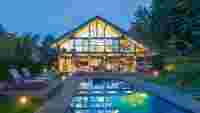Prefabricated Housing Electrical Installations: HUF HAUS Has a Holistic Concept of Quality

Speed and quality do not have to exclusives – even in housing construction. The renowned prefabricated, half-timbered housing manufacturer, HUF HAUS, proves this, down to the smallest detail.
“But those are not prefabricated houses,” states the young woman incredulously to her companion as they watch a robotic mower complete its last swath across the soft green lawn. The couple is walking past numerous sample homes in the HUF village among the hills of Hartenfels. HUF HAUS, a family-owned company entering its third generation, manufactures prefabricated, half-timbered buildings, at its company location in Hartenfels, which include numerous smart home applications designed for the European market. The modern architectural gems, with their transparent wood-glass visual appeal, are also found in China, Russia, and the USA. The characteristic HUF houses stand completely outside of the commonly accepted opinion that prefabricated houses are rather underwhelming in their design.


